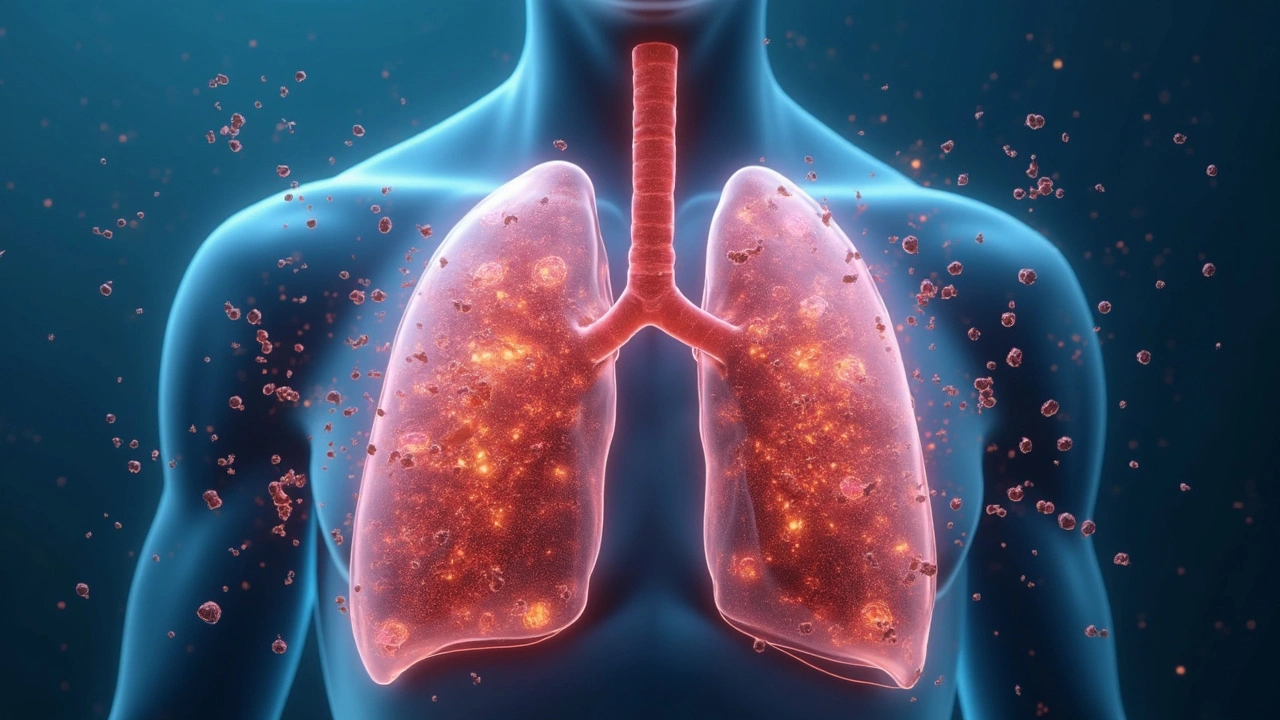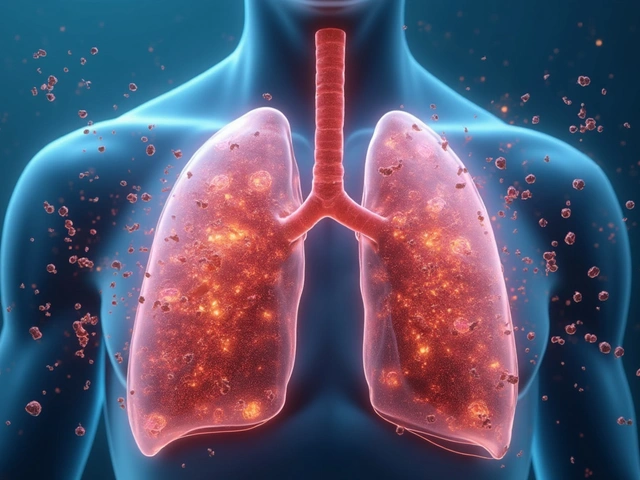Could a mineral imbalance make it harder for you to breathe? We usually think of sodium in terms of heart health or avoiding those salty snacks, but it turns out, sodium is like a backstage crew member for your lungs too. Especially if you're dealing with hyponatremia—when those sodium levels are lower than a sunken treasure—it can spell trouble for your respiratory health.
Imagine sodium as the body's messenger. It's important in sending electrical signals that help your muscles and nerves talk to each other, keeping everything in sync. Now, if sodium hits the low notes, even your breathing muscles can miss a beat. This is why it's crucial to understand the link between hyponatremia and respiratory issues—it could make all the difference in breathing easy.
So, how do you know if low sodium is knocking the wind out of your lungs? Well, there are signs. Think fatigue, trouble focusing, and even confusion. But here's the kicker—these symptoms can often be confused with everyday tiredness or stress. Knowing the difference can lead you to faster diagnosis and better handling of hyponatremia.
- Understanding Hyponatremia
- Sodium's Role in Lung Function
- Hyponatremia and Breathing Problems
- Symptoms and Diagnosis
- Prevention and Management
Understanding Hyponatremia
Alright, let’s talk about something our bodies usually handle perfectly on their own—sodium levels. But when things go sideways and these levels drop too low, we enter the realm of hyponatremia. So what exactly is happening here?
Hyponatremia is when the sodium in your bloodstream gets diluted, falling below the normal range of 135-145 milliequivalents per liter (mEq/L). Think of sodium as the unsung hero that helps maintain a balance of water in and around your cells.
Causes of Hyponatremia
Now, you might be wondering, "How do we mess this up if our bodies are so good at it?" Well, a few things can throw a wrench into the works:
- Excessive water intake: Chugging too much water in a short time can dilute sodium levels.
- Medications: Some meds like antidepressants and painkillers can side-swipe your sodium balance.
- Underlying conditions: Disorders like kidney problems, heart failure, and liver disease mess with how much water you keep, impacting sodium concentration.
Detecting Hyponatremia
Spotting low sodium levels can be tricky because signs often masquerade as other issues. A few things to look out for include:
- Headaches that don't budge
- Feeling confused or having brain fog
- Muscle weakness (even walking feels like a workout)
Having a blood test is the sure-fire way your doc can diagnose hyponatremia. They'll check your sodium levels and assess any underlying causes aiming those low numbers your way.
Treatment Options
Depending on what's causing your sodium slide, the treatment game plan can vary. Common solutions involve:
- Addressing the root cause, be it switching a med or treating an underlying health issue.
- Adjusting your fluid intake to achieve balance.
- In some cases, hospital visits with saline solutions might be in the cards.
Understanding hyponatremia is a big piece of the puzzle in preventing complications. Catching it early can keep everything—especially your breathing—in perfect harmony.
Sodium's Role in Lung Function
Sodium might not be the first thing you think about when it comes to your lungs, but it's like the unsung hero of respiratory health. This trusty mineral is key for keeping the show running smoothly.
Let's break it down. Sodium helps balance fluids in your body, and it also plays a big role in transmitting nerve signals. Both of these functions are crucial when it comes to breathing. Our breathing muscles, like the diaphragm, need that steady flow of signals to contract and relax properly, letting you take in air and expel it like clockwork.
The Electrolyte Connection
Sodium is one of the star players in an electrolyte team. You know, like a band that keeps the rhythm going? These electrolytes help keep your cells charged and ready to work. And when it comes to your lungs, they need this charge to keep everything ticking. If you’re low on sodium—hello, hyponatremia—those charges might get disrupted, leaving your lung function feeling out of tune.
Fluid Balance and Lung Health
Another thing sodium does is help manage fluid levels. This doesn't just stop at keeping you hydrated, it's crucial in preventing fluid overload around the lungs. When your sodium levels drop, your body might hold onto water, sometimes leading to a condition known as pulmonary edema, where excess fluid fills the lung tissues. Not exactly what you want when you need to catch your breath.
Scientific Insights
Recent studies show a clear connection between sodium levels and respiratory health. For instance, people with respiratory disorders often exhibit altered sodium levels, which can exacerbate symptoms. Adjusting these levels has shown significant improvements in certain lung conditions.
| Normal Sodium Range (mEq/L) | Impact on Lungs |
|---|---|
| 135-145 | Optimal lung function, balanced fluid levels |
| Below 135 | Possible lung complications, fluid retention |
So, while it’s easy to overlook, paying attention to your sodium can be a game-changer for your lungs. Keep that electrolyte balance in check, and your lungs might just breathe a little easier.

Hyponatremia and Breathing Problems
When it comes to hyponatremia, the term might not immediately ring alarm bells for breathing issues, but the connection is real. So, what gives? Well, low sodium levels can bring about a unique cocktail of trouble for your lungs. One of the main ways is through the mess it creates in fluid balance. Your lungs need the right fluid levels to function, and hyponatremia can throw this balance off, making it tougher to breathe.
What Happens Inside?
Let’s break it down a little. Sodium helps nerve signals travel smoothly, and the muscles in your respiratory system need these signals to keep doing their job. Take that away, and your diaphragm, the main muscle involved in breathing, might not contract as efficiently. This can leave you feeling breathless or having shortness of breath even with minimal exertion. Not fun, right?
Who's at Risk?
Hyponatremia can hit anyone if the conditions are right (or wrong, rather), but certain groups are more likely. Older adults or individuals with underlying health conditions like congestive heart failure or kidney disorders typically find themselves at a higher risk. These are folks who might already be dealing with respiratory disorders, so adding sodium imbalance to the mix can worsen their symptoms.
Real-world Impacts
Let’s crunch some numbers for context. About 15-20% of patients in healthcare settings might suffer from hyponatremia, and its resolution is critical for proper lung function, especially in intensive care units. As statistics tell us, the balance of sodium is not just about avoiding dizziness; it could directly impact how well you’re able to fill your lungs with air.
So if you or someone you know encounters any strange breathing challenges alongside symptoms like nausea or confusion, it might be time to check those sodium levels. Staying informed could be your first step towards a breath of fresh air—literally.
Symptoms and Diagnosis
Spotting hyponatremia isn't always straightforward because its symptoms can be pretty sneaky. You might just feel a bit off, like you're having an off-day, but there are particular signs to keep an eye on.
Common Symptoms
Low sodium levels can lead to a mix of symptoms, some of which are pretty subtle:
- Feeling unusually tired or weak
- Headaches that don't seem to quit
- Muscle cramps or spasms
- Nausea or vomiting
- Mood changes like confusion or irritability
These may seem harmless, but they're worth noting, especially if you notice them hanging around.
Serious Symptoms
If hyponatremia takes a turn for the worse, it might lead to more severe symptoms like:
- Seizures
- Extreme fatigue or lethargy
- Loss of consciousness
- Difficulty breathing
If you or someone you know experiences these, it's a sign to seek medical attention, STAT.
Diagnosis Process
Getting a handle on hyponatremia involves a few steps. First, the doc will likely ask about your symptoms and medical history. Then, they're going to want some solid proof. Here's where blood tests swoop in to save the day.
These blood tests check sodium levels, and the normal range is between 135 and 145 milliequivalents per liter (mEq/L). If yours drop below 135, you've entered the low sodium zone.
In some cases, healthcare providers might also want to keep an eye on your urine to see if your body is holding on to too much or too little sodium, giving more clues on what's going on.
Now, one interesting bit—every year, about 1.7 million folks in the U.S. get diagnosed with hyponatremia, so you're definitely not alone if this pops up in your test results.
Keeping tabs on symptoms and chatting with your doctor are key. It's better to be in the know than to let a simple sodium slip turn into a full-blown health issue.

Prevention and Management
Tackling hyponatremia head-on might seem a bit daunting, but don't worry, there are smart steps you can take to keep your sodium levels in check and your lungs happy.
Daily Habits to Keep Up
First off, it's about what you eat and drink. Stay hydrated but remember, it's all about balance. Chugging too much water at once? Well, that can dilute sodium levels faster than you think. Aim for steady hydration throughout the day.
Paying attention to your diet can also help. Foods rich in sodium aren't always bad news. In moderation, things like whole-grain bread, fish, and dairy can help maintain sodium levels without turning your diet into an episode of "Salt Binge."
When to Call the Doc
Sometimes, hyponatremia can sneak up on you, especially if you're on certain medications like diuretics or have health issues like kidney problems. Regular check-ups can help catch any drops in sodium early.
If you notice symptoms like serious headaches, confusion, or muscle cramps, it's probably time to get that sodium checked. Doctors might suggest simple blood tests to nail down the culprit behind those pesky symptoms.
Managing Hyponatremia
If you're already dealing with low sodium levels, don't panic. Treatment often starts with addressing the underlying cause. Maybe it's as simple as adjusting medications or diet tweaks. In more severe cases, you might find yourself needing sodium supplements or even IV fluids if things get really tricky.
Your doctor should guide you through this, ensuring a solid plan is in place.
| Method | Description |
|---|---|
| Diet Modification | Incorporate sodium-rich foods while ensuring overall balanced nutrition. |
| Fluid Monitoring | Ensure proper hydration but avoid overconsumption of water. |
| Medication Adjustment | Review any medications with your healthcare provider that might affect sodium levels. |
Staying informed and proactive goes a long way in managing hyponatremia. A healthy balance means less stress for your lungs and a smoother day-to-day life.





Richie Lasit
March 22, 2025 at 18:08Bro, I never thought sodium could mess with breathing like this. I thought it was just about blood pressure and chips. But now I get it-low sodium = weak diaphragm = gasping like a fish on land. My grandpa had this weird fatigue and confusion for months, and they finally found his sodium was at 128. He was basically suffocating in slow motion. Mind blown.
Don't ignore brain fog if it sticks around. It’s not just stress. Could be your electrolytes throwing a tantrum.
arthur ball
March 23, 2025 at 04:56OMG I JUST REALIZED I’M A HYPO-NATRIEMIA WAITING TO HAPPEN. I drink 3 liters of water a day because ‘hydration is life’ and now I’m reading this like it’s a horror movie. My hands cramp at night, I zone out mid-convo, and I thought I was just tired from work. NOPE. IT’S MY SODIUM SCREAMING FOR HELP.
Anyone else chug water like it’s a competition? Let’s stop. Please. I’m scared.
Harrison Dearing
March 24, 2025 at 09:50Lmao. Another ‘hidden cause’ article. Next they’ll say your Wi-Fi router is causing hyponatremia. Sodium’s important, sure. But this is just medical fearmongering dressed up as ‘science.’ People don’t just randomly drop sodium levels unless they’re drinking rainwater in a cult or on a juice cleanse.
Get a blood test if you’re paranoid. Otherwise, stop reading clickbait that turns electrolytes into a thriller.
Justice Ward
March 25, 2025 at 07:25This hit different. I used to think of sodium as this villain from nutrition blogs, but learning it’s the quiet conductor of your breathing muscles? That’s poetic. Like your body’s own orchestra, and sodium’s the maestro keeping the diaphragm in rhythm.
My cousin in ICU had this exact thing-breathing shallow, confused, like her lungs forgot how to work. They gave her saline, and within hours, she blinked like she’d woken from a dream. It’s not just a number on a lab report. It’s the difference between gasping and breathing easy.
Let’s stop treating minerals like background noise. They’re the heartbeat under the skin.
bhuvanesh kankani
March 27, 2025 at 03:30As someone from India where hydration myths are deeply rooted, I must emphasize caution. Many believe drinking excessive water is always beneficial, especially during summer. However, this post rightly highlights the danger of dilutional hyponatremia, particularly among elderly and those with chronic conditions.
Public awareness is lacking. In rural clinics, we often see patients with altered mental status due to low sodium, misdiagnosed as stroke or dementia. This article serves as a vital educational tool. Thank you for bringing attention to this silent respiratory threat.
maria norman
March 28, 2025 at 17:47So let me get this straight-you’re telling me my daily ‘I’m so hydrated’ Instagram story is actually turning my lungs into a swamp? How poetic. The modern human: drowning in water, starving for salt, and blaming their exhaustion on ‘burnout.’
Meanwhile, our ancestors survived on salted fish and sweat. We, however, need a PhD in electrolytes to not accidentally suffocate ourselves. Progress, am I right?
Iris Schaper
March 29, 2025 at 09:09wait so if you drink too much water you can literally stop breathing? that sounds like a myth but i read the whole thing and now im scared. i drink a gallon a day. i thought i was being healthy. now i think i’m just a walking lab experiment.
also why is sodium so important? i always thought it was just for tasting good on fries
katerine rose
March 30, 2025 at 18:52Stop overcomplicating this. You’re not gonna die from drinking too much water unless you’re a marathon runner chugging Gatorade like it’s free. If you’re not vomiting or seizing, stop freaking out. This post is just fear porn for people who Google every ache and call it a disease.
Also, your lungs don’t need sodium. Your brain does. And if you’re confused, maybe stop reading Reddit at 3am.
Selma Cey
April 1, 2025 at 04:39What if sodium isn’t the hero here? What if it’s just a scapegoat for our obsession with quantifying every biological function? We’ve turned the human body into a spreadsheet. ‘Optimal sodium range’-as if life can be reduced to a lab value.
Maybe the real issue is that we’ve lost touch with our instincts. We don’t listen to our bodies anymore-we just check our apps for ‘hydration scores.’
So yes, sodium matters. But maybe the real hyponatremia is the one in our relationship with nature.
Francis Pascoe
April 1, 2025 at 06:32You people are so naive. This isn’t about hydration. This is about the pharmaceutical industry pushing ‘electrolyte imbalance’ as a diagnosis so they can sell you IV drips at $500 a pop. You think your doctor cares if your sodium’s low? No. They care if you pay for the test. Then the follow-up. Then the ‘specialized’ supplement.
Read the studies. Most cases of hyponatremia are in hospitals, not your living room. If you’re not in a coma, stop listening to this fear-mongering. Your lungs are fine. Your anxiety? Not so much.